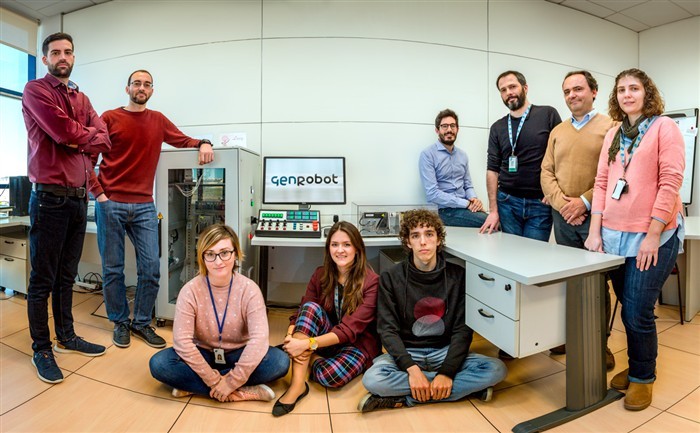GENROBOT- the software that Europe will use in its share of ITER Remote Handling systems

Representatives of GTD and F4E around the test bench of GENROBOT, GTD offices, Madrid, Spain. GENROBOT will be used to adapt and configure robotics equipment which will operate as part of Europe’s ITER Remote Handling system. (Image courtesy: Rod New house)
ITER, the biggest fusion device, counts at least one million main components. And this is not all. If you add its subcomponents and their multiple interfaces it is clear that this machine competes in the league of big science projects. Engineers involved in one of the largest international experiments of our time face several challenges: manufacturing these one-of-a-kind pieces of equipment is no easy task; assembling them in a seamless manner seems complex; and last but not least, operating them may prove to be technology’s next giant leap. Remote Handling brings together the systems and tooling which will be required to inspect, repair, move and replace the components that will be exposed to radiation. Given the fact that humans will not physically enter ITER’s massive vessel, all maintenance works will be carried out remotely. Teams from Europe and Japan are working relentlessly with companies and laboratories to design and manufacture the pieces of equipment that will allow us to perform these tasks. Man-in-the-loop robotics such as manipulators, movers, cranes and actuators will be deployed to work with extreme precision. Like a choreography where everyone has a role to play and every single step matters, they all have to “dance” to the same music and understand in their coded language what needs to be done.
The multilingual environment of the European Union was the birthplace of a software which helps various pieces of robotic equipment to communicate and work together as part of the same system. The foundations of the idea are traced in the European Commission’s Joint Research Centre (JRC) in Ispra, Italy, where GENERIS was born. The software was masterminded by a team of engineers, led by F4E’s Emilio Ruiz Morales, who at the time was working in Ispra. The application has made excellent use of the know-how stemming from R&D projects financed by the JRC in areas such as mobile robotics for surveying nuclear storage, and telerobotics surgery with tactile feedback. GENERIS inspired F4E and GTD to create GENROBOT, a new software which will be part of the European Remote Handling systems in ITER.

“This software allows us to install a sense of harmony in the operating system and to rigorously control all ITER Remote Handling machines that Europe has to manufacture. Engineers can adapt and configure it to operate various robotics equipment. Thanks to GENROBOT we have made time and cost savings. Above all, we have developed an industrial software system of outstanding quality, complying with SIL-2 IEC 61508 standards, which is a novelty for the market,” explains Ruiz Morales.
Carlo Damiani, heading F4E’s ITER Remote Handling systems, highlights how ITER’s technically demanding environment has become a driving force for further innovation. “First, we need to carry a meticulous analysis of the state-of-the art and then decide whether we have to invest further in R&D. In the case of GENROBOT, we made excellent use of EU funded research. With further investment from our side we made an innovative software that suits our needs and potentially those of other areas using remote applications such as nuclear decommissioning, defense, medicine and space,” he explains.
“GENROBOT allowed us to enter the robotics market by contributing through our expertise in safety-critical software. For us it has been an interesting journey which helped us acquire new capabilities and made us step out of our comfort zone,” explains Alejandro Cantos, GTD Robotics Manager. “We are now in a position to use all the know-how obtained with GENROBOT and to offer solutions to other markets. Being part of Europe’s contribution to ITER is a dream come true. It is one of the most important projects in the world upon which the future of the energy depends.”
The testing phase of GENROBOT at GTD is soon coming to an end. Further fine-tuning is expected to be carried out during the first semester of 2019. Then, it will travel to ITER’s Remote Handling Facility, Tampere, Finland, where experts will receive training to perform various tests at the Divertor Test Platform (DTP2).